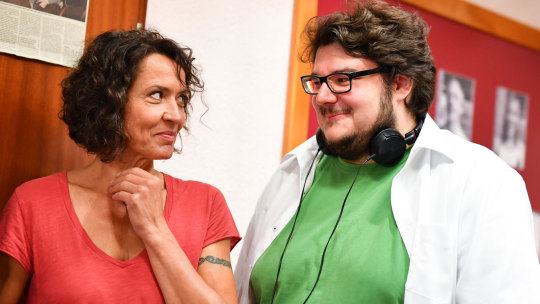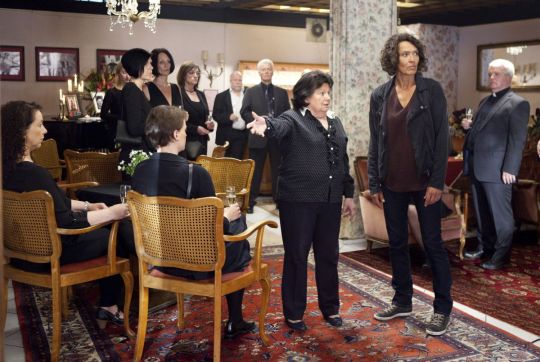#then next season opens with a montage of Sophie leading up to that ball
Explore tagged Tumblr posts
Text
I’m just saying they have a perfect opportunity to have a ball with the promise of “unmasking” Lady Whistledown and doing a masquerade party and that’s when Benedict meets Sophie.
#bonus points for not knowing ANYTHING about her like Ben#then next season opens with a montage of Sophie leading up to that ball#bridgerton#benophie#benedict x sophie#bridgerton season three#crafting a narrative for a book I hate#this is Luke T’s fault for being likable#sorry if anyone has already pointed this out! I just think too much sitting on my couch
21 notes
·
View notes
Text
Improv Stage As Crime Scene – Axel Ranisch Does Tatort

November 1, 2016
While “quality” and “innovation” seem to be the attributes that US and British TV producers like to define their work as, in Germany “tradition” and “ritual” (as in private, pub and public viewing every Sunday evening at 8:15) are the watchwords – and they probably explain the appeal of weekly (with seasonal hiatuses) detective show “Tatort” (crime scene).
First broadcast in 1970 and gearing up for its 1000th episode on November 13, 2016, “Tatort” takes the federalist public broadcasting system in Germany and turns it into a unique feature of the series. Each state broadcaster has one or two crime-fighting teams that solve cases grounded in the regions they’re based in. That means lots of location shooting and detectives with regional accents and (stereotypical) traits like earthy, tough but tender “Ruhrpötter” Horst Schimanski, operating in Duisburg in the Western German coal-mining Rhein-Ruhr metro area. The hard-drinking, hard-loving and quick-tempered Schimanski, a 1980s departure from the heretofore straitlaced “Tatort” cops, was no less credible as played by the late acting legend Götz George, a native and life-long Berliner. Schimanski was also the first true superstar “Tatort” detective. In the pre-Schimanski era, how many people remember who was on the case in “Reifezeugnis” (1977), which put director Wolfgang Petersen on the map? (Kommissar Finke, played by Klaus Schwarzkopf, investigated.) However, almost everybody remembers the other beneficiary of that episode’s success, then 15 year-old Nastassja Kinski, who played a precocious femme fatale. Even if “Tatort” never had the most intricate plots, it serves as a map and social barometer (issues from child abuse to xenophobia are regularly explored) of the past 45+ years of West and reunited Germany.
To its credit, “Tatort” has tried to flex its dramatic and stylistic muscles, with varying degrees of success. 2014’s Frankfurt set “In Schmerz geboren” (Born in Pain), directed by Florian Schwarz and featuring Ulrich Tukur as Detective Felix Murot and Ulrich Matthes as his best friend turned nemesis Richard Harloff, achieved stratospheric acclaim. But do the show’s makers seriously expect a medal for heavy-handed Shakespeare references and vapid Tarantino knock-offs? Then there have been interesting variations within the detectives‘ characters. Some, like Jan Josef Liefers‘ Professor Boerne, take more than a page or two from the playbook of eccentric yet loveable forensic medicine geniuses in US series from “CSI” to “Bones”, but the comically vain Boerne is great fun to watch in tandem with schlubby yet can-do sidekick Frank Thiel (Axel Prahl as perfect foil). Others like the romantically involved Lessing and Kira Dorn don’t give the otherwise talented Christian Ulmen and Nora Tschirner, who can handle both the comic roles that established their careers as well as more serious fare, much to work with. Now, “Tatort”, the epitome of genre routine, has opened itself up to the free-wheeling improvisational process of director-actor Axel Ranisch.
Ranisch has become one of Germany’s most acclaimed new talents. His body of work includes “Heavy Girls”, famously produced for 517 euros, with support from his grandmother (lovely as one the three leads) and a founding text of the “German Mumblecore” wave of low budget, character-driven films; camp coming out and of age stories (“I Feel Disco”); fairy tales with a twist (“Reuber”) and the surreal addiction psychodrama “Alky Alky”. Ranisch studied under queer cinema icon Rosa von Praunheim at the Media University Konrad Wolf in Potsdam-Babelsberg and has cultivated an improvisational technique and reperatory company (did somebody say Cassavetes or Fassbinder?) centring around Schillertheater alumnus Heiko Pinkowski and acting newcomer Peter Trabner. Pinkowski and Trabner have since become German Mumblecore posterboys, and Trabner worked as improv coach (in ten cast workshops stretched over the course of a year) on the Ranisch “Tatort” episode, intriguingly and onomatopoetically titled “Babbeldasch”.

“Babbeldasch” is Palatine dialect for “blabbermouth” and the name of a (fictitious) dialect theater (shot in the Hemshofschachtel theater) in the southwestern German city of Ludwigshafen. This Rhineland town is the turf of detectives Mario Kopper (Andreas Hoppe), Johanna Stern (Lisa Bitter) and Lena Odenthal (Ulrike Folkerts). Lena Odenthal’s first case was in 1989, as only the third ever female “Tatort” detective. Now after 17 seasons she’s the series‘ senior crimefighter. The Odenthal character, as Folkerts portrays her, has been hailed as a fresh, self-confident, resourceful and well-rounded female role model (while Folkerts was one of the first “out” German female stars). In “Babbeldasch” Folkerts, her fellow “Tatort” cast members and non-professional actors seemingly revel in Ranisch taking them out of their comfort zones: working without a script, shooting in sequence and not knowing the story’s resolution beforehand.
This episode’s mystery involves the death of Sophie Fetter (played by Hemshofschachtel director Marie-Luise Mott), the impresario and diva of “Babbeldasch”. Odenthal and her colleague Peter Becker coincidentally witness the tragic incident while in the audience. What is first diagnosed as a lethal allergic reaction to poppyseed in a chocolate croissant might actually be more sinister. Sophie certainly was involved in enough potentially perilous personal and professional intrigue: a volatile love triangle, disgruntled ensemble members, estranged daughter (Petra Mott, Marie-Luise’s real-life daughter) and a greedy landlord eager to get his hands on the property for which Sophie had a lifelong lease. Odenthal should be off duty to compensate overtime, but Sophie keeps appearing to her in dreams, admonishing her to find the killer. So the next thing we know, Odenthal is undercover, acting a part (of dramatically inclined social worker) amongst the actors. The recurring dream sequences are just one of several well-placed running gags, which also include the improvised care of Johanna Stern’s toddlers and a flu-like bug.
As a “Tatort” episode set in the world of theater and artifice would have it, there’s no shortage of meta moments and fourth-walling. Johanna Stern refers to “Murder On The Orient Express” when she says everyone had a motive and maybe everybody did it all together. Lisa Bitter as Stern then hits the ball out of the park in a hilarious montage sequence of her interrogation of the entire “Babbeldasch” ensemble, keeping her face and the stories straight while wearing an absurd white protective suit. Odenthal also seems to be ever so subtly winking to the audience on some occasions.
At a Q&A after a preview coinciding with the opening of the “1000 Tatorte” exhibition at the Film Museum in Berlin, Folkerts commented that Odenthal is enjoying her life in “Babbeldasch” more than she has been in previous films, and that she hopes that this will continue. Bitter tempered her reportedly negative remarks about the improv process by saying at first the exercises brought back awkward memories of acting school, but then she got into it. Regular “Tatort” viewers also noted Odenthal’s flash new riverside digs, which apparently will be featured in future episodes. (Odenthal’s cat, largely absent in “Babbeldasch”, will return, Folkerts assured the audience.) Most importantly, one hopes that Ranisch’s spirit will sustainably impact “Tatort”’s aesthetic growth – maybe without year-long improv workshops but with a sense of adventure and discovery that the audience can share.
„Babbeldasch“ will be broadcast in early 2017. Watch films by Axel Ranisch on realeyz. The exbition „1000 Tatorte“ is on view until January 17, 2017 at the Museum of Film and Television Berlin.
0 notes